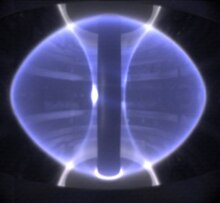 Global Information
Global InformationMagnetic confinement fusion information

Magnetic confinement fusion (MCF) is an approach to generate thermonuclear fusion power that uses magnetic fields to confine fusion fuel in the form of a plasma. Magnetic confinement is one of two major branches of controlled fusion research, along with inertial confinement fusion.
Fusion reactions for reactors usually combine light atomic nuclei of deuterium and tritium to form an alpha particle (Helium-4 nucleus) and a neutron, where the energy is released in the form of the kinetic energy of the reaction products. In order to overcome the electrostatic repulsion between the nuclei, the fuel must have a temperature of hundreds of millions of degrees, at which the fuel is fully ionized and becomes a plasma. In addition, the plasma must be at a sufficient density, and the energy must remain in the reacting region for a sufficient time, as specified by the Lawson criterion (triple product). The high temperature of a fusion plasma precludes the use of material vessels for direct containment. Magnetic confinement fusion attempts to use the physics of charged particle motion to contain the plasma particles by applying strong magnetic fields.
Tokamaks and stellarators are the two leading MCF device candidates as of today. Investigation of using various magnetic configurations to confine fusion plasma began in the 1950s. Early simple mirror and toroidal machines showed disappointing results of low confinement. After the declassification of fusion research by the United States, United Kingdom and Soviet Union in 1958, a breakthrough on toroidal devices was reported by the Kurchatov Institute in 1968, where its tokamak demonstrated a temperature of 1 kilo-electronvolts (around 11.6 million degree Kelvin) and some milliseconds of confinement time, and was confirmed by a visiting team from the Culham Laboratory using the Thomson scattering technique.[1][2] Since then, tokamaks became the dominant line of research globally with large tokamaks such as JET, TFTR and JT-60 being constructed and operated. The ITER tokamak experiment under construction, which aims to demonstrate scientific breakeven, will be the world's largest MCF device. While early stellarators of low confinement in the 1950s were overshadowed by the initial success of tokamaks, interests in stellarators re-emerged attributing to their inherent capability for steady-state and disruption-free operation distinct from tokamaks. The world's largest stellarator experiment, Wendelstein 7-X, began operation in 2015.
The current record of fusion power generated by MCF devices is held by JET. In 1997, JET set the record of 16 megawatts of transient fusion power with a gain factor of Q = 0.62 and 4 megawatts steady state fusion power with Q = 0.18 for 4 seconds.[3] In 2021, JET sustained Q = 0.33 for 5 seconds and produced 59 megajoules of energy, beating the record 21.7 megajoules released in 1997 over around 4 seconds.[4]
One of the challenges of MCF research is the development and extrapolation of plasma scenarios to power plant conditions, where good fusion performance and energy confinement must be maintained. Potential solutions to other problems such as divertor power exhaust, mitigation of transients (disruptions, runaway electrons, edge-localized modes), handling of neutron flux, tritium breeding and the physics of burning plasmas are being actively studied. Development of new technologies in plasma diagnostics, real-time control, plasma-facing materials, high-power microwave sources, vacuum engineering, cryogenics and superconducting magnets are essential in MCF research.
- ^ Peacock, N. J.; Robinson, D. C.; Forrest, M. J.; Wilcock, P. D.; Sannikov, V. V. (November 1969). "Measurement of the Electron Temperature by Thomson Scattering in Tokamak T3". Nature. 224 (5218): 488–490. Bibcode:1969Natur.224..488P. doi:10.1038/224488a0. ISSN 0028-0836. S2CID 4290094.
- ^ Holloway, Nick (2019-11-22). "Mission to Moscow: 50 years on". Culham Centre for Fusion Energy. Retrieved 2023-08-22.
- ^ Keilhacker, M; Gibson, A; Gormezano, C; Rebut, P.H (December 2001). "The scientific success of JET". Nuclear Fusion. 41 (12): 1925–1966. doi:10.1088/0029-5515/41/12/217. ISSN 0029-5515. S2CID 250759123.
- ^ Gibney, Elizabeth (2022-02-09). "Nuclear-fusion reactor smashes energy record". Nature. 602 (7897): 371. Bibcode:2022Natur.602..371G. doi:10.1038/d41586-022-00391-1. PMID 35140372.